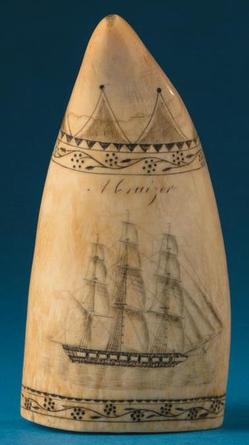Scrimshaw refers to dec orative engraving done on pieces of bone or ivory. The term is occasionally expanded to include some sculptures or figurines made from the same materials, although this is more accurately ivory or bone carving. One who practices the art of scrimshaw is known as a scrimshander. An ancient art, scrimshaw grew considerably in popularity during the mid-18th century, the boom years of the whaling industry, as it was chiefly a hobby during long voyages for sailors on whaling ships who had ready access to the bones and teeth of sperm whales as byproducts of whaling. (Scrimshaw work is also often seen on baleen, a keratin substance, that forms the plates in the mouths of a suborder of whales that includes humpback, grey, right and blue whales, as well as on the tusks of walruses.) Teeth were often engraved “as is” with everything from romantic sentiments to whaling scenes to political statements, while baleen was almost plastic-like in its versatile nature and was occasionally used for engraved busks (stay-like supports in women’s corsets). Walrus tusks were engraved with the same scenes, but were also occasionally drilled with holes to serve as highly decorated cribbage boards. The most desirable pieces have, of course, the most intricate carvings, but examples are also highly prized for unusual subject matter or identifying inscriptions (ship or ship’s officer names, dates, intended recipient, etc.).
orative engraving done on pieces of bone or ivory. The term is occasionally expanded to include some sculptures or figurines made from the same materials, although this is more accurately ivory or bone carving. One who practices the art of scrimshaw is known as a scrimshander. An ancient art, scrimshaw grew considerably in popularity during the mid-18th century, the boom years of the whaling industry, as it was chiefly a hobby during long voyages for sailors on whaling ships who had ready access to the bones and teeth of sperm whales as byproducts of whaling. (Scrimshaw work is also often seen on baleen, a keratin substance, that forms the plates in the mouths of a suborder of whales that includes humpback, grey, right and blue whales, as well as on the tusks of walruses.) Teeth were often engraved “as is” with everything from romantic sentiments to whaling scenes to political statements, while baleen was almost plastic-like in its versatile nature and was occasionally used for engraved busks (stay-like supports in women’s corsets). Walrus tusks were engraved with the same scenes, but were also occasionally drilled with holes to serve as highly decorated cribbage boards. The most desirable pieces have, of course, the most intricate carvings, but examples are also highly prized for unusual subject matter or identifying inscriptions (ship or ship’s officer names, dates, intended recipient, etc.).
While scrimshaw is still practiced today, laws like the Endangered Species Act and other international laws that protect whales (and elephants, whose tusks were also often carved and are still sought by poachers today for their value) have changed the availability of ivory. Depending on the age of the piece, these same laws may make certain requirements or restrictions when it comes to buying and selling ivory as well.



